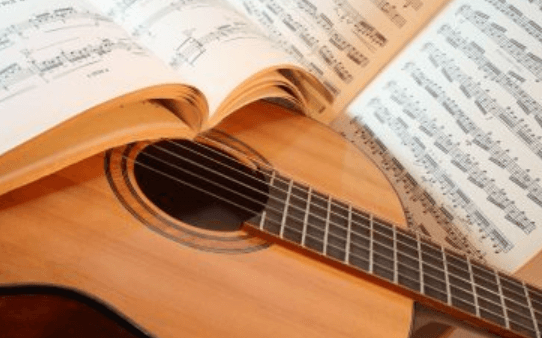How to Learn Guitar Beginner

Learning to play guitar beginner requires consistent practice. Developing technique and finding your own unique style will come with time.
Start by practicing strumming chords. Be sure to strum from the thickest string down to the thinnest, and try adding up and down strums as well.
Remember to strum lightly so the strings do not snag and produce a “clunk.” This will help your chords sound clean and clear.
Scales
Many guitarists dismiss scales as boring — and they can be, if you don’t know how to make them fun. However, if you take the time to learn scale patterns, they can help you develop your finger technique and become a better soloist. They can also be the foundation for learning chords and chord progressions, which are the building blocks of most songs. Scales are also the key to understanding how to read music — an essential skill for any musician.
A musical scale is a sequence of notes that ascends and descends through a variety of intervals, or steps (or pitches). The most basic kind of scale has only five notes, so it’s easy to remember. Most scales are based on one of the chromatic modes: major, minor, or diminished. These are the tones you hear in most of the popular music you listen to.
There are several ways to practice scales, but the most important thing is to do it often. Start with a simple pattern, such as the major pentatonic scale, and gradually add more notes as you master them. Then practice improvising over a backing track, trying out different note clusters. It’s also a good idea to use a metronome, and play at a slow, comfortable speed before gradually increasing the tempo.
Practicing scales will help you to become more familiar with the fretboard and see how patterns repeat across the neck of the guitar. This will allow you to navigate more easily through the chords you play, and it will enable you to pick out melodies over them more quickly and effectively. You’ll also find that learning scales is the best way to see the relationships between notes on the fretboard — for example, that the same pattern of intervals can be used to build both arpeggios and chord shapes.
Scales are essential for any musician, but they are especially valuable for guitar beginners. They’re the skeleton that supports the muscles of your guitar playing, and they’re the basis for riffs, solos and chords. It’s a mistake to ignore them, as many musicians do — especially new artists, like Darwin Deez, who has a creative sound that requires no scale knowledge.
Chords
Getting to grips with chords is one of the most important parts of learning guitar for beginners. A beginner must be able to form simple open chords, as well as barre chords that can be moved up the neck of the guitar as their skill and understanding develop. Getting a handle on both types of chords will allow a learner to play a much wider variety of songs and styles.
Chords are made from specific notes within a scale and can be major, minor, or diminished. It is important to learn a basic scale before moving on to chords as they will help the student understand how these different chords are made up of the same notes within the scale.
The basic open chords, C, A, G, and D are easy for beginners to pick up and use. These can be used to play a lot of popular music. Once the beginner has learned these, they can move on to more complex open chords, such as Am and Em. These can be played on acoustic or electric guitar and can also be distorted to create a heavier sound.
Once a learner has mastered these basic chords, they can then progress on to barre chords which can be moved up the fretboard. These can be played on both acoustic and electric guitar and are great for rock, punk, and metal music.
When making a barre chord, it is important to remember to not press down too hard on the strings. This can cause the strings to become muffled or buzzy. It is a good idea to practice the chords with your thumb in between your fingers to make sure that you are not pressing down on them too hard. Curving your fingers can also be helpful to avoid touching the strings below which will stop them from ringing out clearly.
It is a good idea to learn a chord diagram which will show the strings that are being played, the frets that are being used, and which finger is being played on each fret. This is very useful for beginners to read so that they can see what chord they are trying to form and where their fingers need to be placed to get the best result.
Rhythm
While learning chords is important for beginners, it’s equally as important for them to develop their rhythm and strumming patterns. This helps them bring their chords to life, creating the pulsing, rhythmic heart of a song. The best way for a apprendre la guitare débutant to master their rhythm is by listening to the music they love and mimicking it as closely as possible. This will allow them to make adjustments based on how the original was performed, which is much more beneficial than trying to guess at the correct rhythm purely through trial and error.
Most new guitarists have trouble with rhythm at first. This is because their fingers are not yet accustomed to the physical act of pressing them against strings. It also takes time to get a feel for how to form chords and use their picking hand properly.
This is why it is recommended that a guitar beginner start with simple songs that utilize only one chord at a time. It will give them a chance to practice their rhythm, while also building up the strength and endurance of their fingers and hands. Once they have gotten the hang of playing these basic songs, they can move on to more complex ones that require multiple chords and more rhythm.
Another thing that a guitar beginner should focus on is learning how to count beats or the recurring rhythm that is found in most pieces of music. This can be done by either counting along in your head, or by using a metronome for added accuracy. Once a learned guitar beginner can accurately count the beats in a piece of music, they should work on splitting those beats into upstrokes and downstrokes. For example, if a piece of music has four beats in a bar, they should practice counting up every other beat and down the rest.
In addition to learning how to count beats, a guitar beginner should also work on developing their ability to mute strings with their palm when needed. This is especially important for those who play rock or metal music, where silenced strings are essential in maintaining the sound of their chords.
Read also What Are The Benefits Of Projector With Bluetooth Connectivity
Fingerpicking
Fingerpicking is the overarching term used to describe using your fingers rather than a pick when playing the guitar. Whether you’re playing complex classical pieces or country blues with a fingerpicking style all your own, the sound that comes from this type of playing is one of the most satisfying as it provides the illusion that your guitar is the entire band. The basic technique is relatively simple to learn, but it will open up a wide range of musical possibilities.
While it may be tempting to favor comfort over technical efficiency when learning fingerpicking, focusing on developing the right picking technique will allow you to become a better guitarist in the long run. You’ll need to have your picking pattern down before you can move on to chords and melody, and that requires practice.
One of the best ways to get started with this is to practice simple patterns on your acoustic guitar. Here are a few to try:
This is an easy pattern that will work with almost any chord, but it’s especially effective on the low E string. To make it easier, start by practicing the pattern on chords that don’t include this low note (for example, G). Once you’re comfortable with this simple pattern, you can try it with more complicated chords and then move on to other styles.
The alternating thumb technique is another popular fingerpicking style. It can be used with both strumming and picking, but it’s particularly effective when strumming. The key to this style is to be able to keep the alternating thumb bassline steady, so practice it often until you can’t shake it.
Windy and warm is another classic fingerpicking song that’s perfect for beginners. It’s a little trickier than Freight Train, but it can be learned quickly with a bit of practice.




